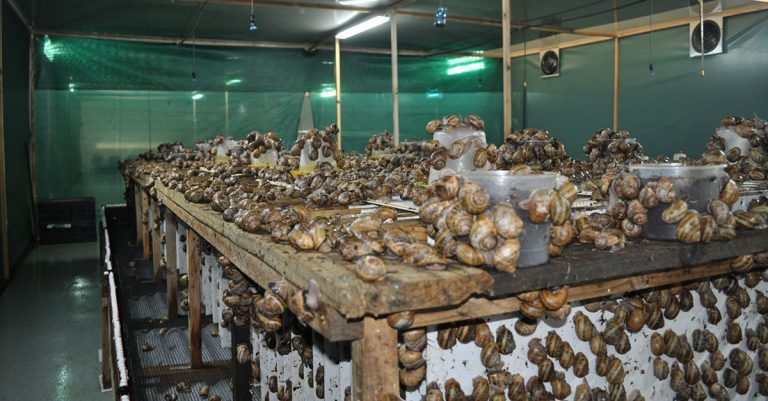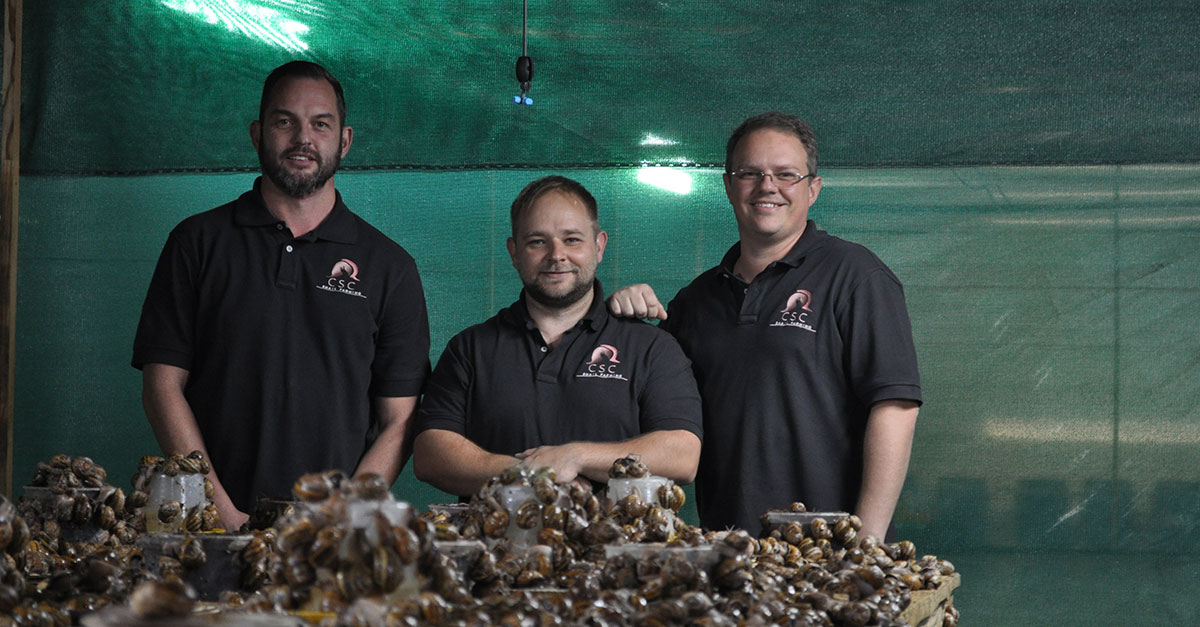
Photo: Pieter Dempsey
Friends Christiaan Jooste, Stephan Pretorius and Coenie Espach started their indoor urban snail-farming operation as a hobby during last year’s COVID-19-related hard lockdown.
Under the business name CSC Heliculture (CSC), they developed a unique system adapted specifically to produce snails indoors, unlike most snail-growing operations in South Africa that follow the outdoor method.
Jooste, Pretorius and Espach live in the same complex, and began the project on a small scale in one of their garages. This is one of the reasons they chose an indoor system; using a vertical farming approach enables them to produce more in a smaller space. An indoor system is also easier to clean, and makes harvesting the eggs less of a challenge.
READ COVID-19 and disillusionment: the impending crisis of unskilled youths
Moreover, it allows them to keep a closer eye on their snails and operation, says Jooste. Most of the issues an outdoor snail farm faces, such as pests, extreme weather conditions and soil bacteria, are also eliminated.
CSC started with 500 breeder snails imported from Lithuania. However, the snails quickly outgrew the available space, producing 70 000 babies in just two months, and the entrepreneurs were thus forced to move the operation to an industrial estate in Centurion, where there were larger indoor premises.

With no previous farming experience, they spent a lot of time learning the ins and outs of the industry and how to efficiently grow snails indoors. Jooste adds that much research was conducted to determine the ideal conditions (temperature, soil and feed) in which to effectively raise snails.
In the beginning, for example, CSC used normal potting soil in which to morph the eggs. They have since switched to river sand and synthetic soil, which provide the eggs with a better environment.
The Helix aspersa maxima, also known as petit gris, is the subspecies of choice for most snail farmers, with demand far higher than total supply in South Africa, says Jooste. He adds that snails carry a lot of value as they have a diverse range of uses in both food and cosmetic products.
Production
After scaling up the operation, CSC imported 50 000 breeding snails from Greece. These snails have been chosen for their ability to produce high-quality snails for consumption. Jooste adds that their 50 000 breeders are able to produce roughly three million eggs, which will provide around 30t of snails per cycle.
He explains that the indoor system allows snails to grow to marketable size within four to five months, as opposed to the traditional outdoor technique, which can take about six months.
READ How to handle 240 000 eggs a day
Jooste says snails that show potential as breeders are separated from the rest of the escargatoire once they reach maturity.
The CSC system can produce around 10t of snails from the first cycle of egg laying to the raising of hatchlings. Jooste believes that as egg quality improves, they will be able to produce around 30t over subsequent cycles.
And, while an outdoor system would require around 1ha to produce the same tonnage, Jooste says their intensive and continuous management and monitoring of production means they can produce this amount on a much smaller area.
The snails are raised in a vertical farming system of around 80 sheets, each of which provides an area of around 2m². The sheets are stacked on tables of about 180m² each. Each square metre provides space for 250 snails. Thus, each table can accommodate approximately 45 000 snails.
“At the moment, we’re using 14 tables housing a total of 630 000 snails in the first cycle, and when running at full capacity with more grower tables, we have space for three million snails,” says Jooste.
The customised ‘grower’ tables consist of wooden planks and netting. Salt borders keep the snails on the tables.
Breeding cycles
Snails are hermaphrodites, having both male and female reproductive organs, and are able to breed from about four months of age.
This occurs in cycles in which they breed for six weeks and are then rested for two weeks. During the resting period, their food and water is removed and they hibernate. “Those that wake up after two weeks are then ready to breed again for six weeks. Some snails produce eggs every 15 days,” says Jooste.
READ Practical tips for starting a rabbit farm
CSC’s snails lay their eggs in irradiated soil in small containers. Each produces between 60 and 80 eggs at a time, and CSC’s current morphing rate is 95%.
At the moment, CSC harvests between 7 000 and 20 000 eggs per day. Jooste says the aim is to produce 100 000 eggs a week as they scale up production.
Temperature, management and feed
The ideal temperature for snail production is 18°C to 24°C, says Jooste. Snails are sensitive to temperature changes, so the temperature is checked every two hours. The humidity is carefully controlled at around 85%.
Moisture is also very important, so the snails are hosed down a few times a day as and when needed. The tables are cleaned on a weekly basis.
The snails receive a specially formulated feed every day that assists with the growth of their shells and boosts their immune systems.
CSC doesn’t use food scraps and only plants certain vegetables for use as feed. Around 7t of feed are used per nine-month cycle. For the breeder snails, 700g of feed is given per 10 000 snails.
“[The babies] receive feed every day, but only eat as required,” says Jooste.
The feed costs around R5 000/t, but the better its formulation, the better its uptake. Snails are nocturnal, and they are thus put on a cycle of 16 hours’ sleep, which means they are awake for eight hours during the night.
“[The time of day] can be manipulated by switching the lights on and off,” says Jooste.
Harvesting and marketing
Jooste reiterates that they do not struggle with diseases or pests as they use a closed,
indoor system. While harvesting the snails is labour intensive, it is easier in the indoor system.
“We don’t have to look for the snails in grass or on the netting, as they are all well contained on the tables. It takes four peoplem a few days to harvest all the snails on the tables.”
CSC’s main market is snail-processing facilities; no processing takes place at the company itself. The snails are sold to the cosmetics industry, where the slime, which makes up around 20% of a snail’s weight, is extracted for use in the production of cosmetics.
Thereafter, the snails move on to the hospitality industry for processing into food products.
Jooste says that while CSC currently uses the eggs to produce more snails, there is a growing market for their use as caviar.
The average price for breeding snails is R7 each, while snails used in the hospitality and cosmetic industries go for around R60/kg of live snails.
When the harvesting of snails begins, the system is essentially ‘switched off’, which means that the snails do not receive any food or water, so they go into hibernation.
They are then harvested, and moved to a mobile cold storage unit, which is kept at a constant temperature of between 8°C and 10°C. Afterwards, they are moved to the processing facility in White River, Mpumalanga.
Email Christiaan Jooste at [email protected].











